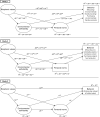Sustainability in Youth: Environmental Considerations in Adolescence and Their Relationship to Pro-environmental Behavior
- PMID: 33224073
- PMCID: PMC7667260
- DOI: 10.3389/fpsyg.2020.582920
Sustainability in Youth: Environmental Considerations in Adolescence and Their Relationship to Pro-environmental Behavior
Abstract
Adolescents today face the negative outcomes of climate change, and their pro-environmental behavior is crucial to mitigate these negative outcomes. Yet, we know little about what influences adolescents' pro-environmental behavior. Research shows that people's biospheric values and environmental self-identity, elicit personal norms to act environmentally friendly, which can induce a wide range of pro-environmental actions. Yet there is no evidence that these factors can influence pro-environmental behavior of adolescents, because this has only been studied for adults. Given that in adolescence, values, identities and moral structures undergo intense development, the question is whether these factors can motivate adolescents to act pro-environmentally. To address this question, we have conducted three studies with adolescents in Lithuania (Study 1: N = 256; Study 2: N = 349; Study 3: N = 905). We found support that adolescents' biospheric values and environmental self-identity were associated, via personal norms, with a wide range of pro-environmental behaviors, including recycling, environmentally friendly traveling, purchasing environmentally friendly goods and drinking tap water. Based on theory and the current findings, we suggest directions for policies aimed at promoting pro-environmental behavior of adolescents.
Keywords: adolescents; biospheric values; environmental behavior; environmental considerations; environmental self-identity; personal norms.
Copyright © 2020 Balundė, Perlaviciute and Truskauskaitė-Kunevičienė.
Figures



References
-
- Ajzen I. (1996). “The directive influence of attitudes on behavior,” in The Psychology of Action: Linking Cognition and Motivation to Behavior, eds Gollwitzer P. M., Bargh J. A. (New York, NY: Guilford Press; ), 385–403.
-
- Ajzen I., Fishbein M. (1980). Understanding Attitudes and Predicting Social Behavior. Englewood Cliffs, NJ: Prince Hall.
-
- Ajzen I., Fishbein M. (2005). “The influence of attitudes on behavior,” in The Handbook of Attitudes, eds Albarracín D., Johnson B. T., Zanna M. P. (Mahwah, NJ: Lawrence Erlbaum Associates Publishers; ), 173–221.
-
- Barbarossa C., De Pelsmacker P. (2016). Positive and negative antecedents of purchasing eco-friendly products: a comparison between green and non-green consumers. J. Bus. Ethics 134 229–247. 10.1007/s10551-014-2425-z - DOI
LinkOut - more resources
Full Text Sources
Miscellaneous

